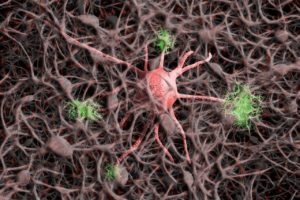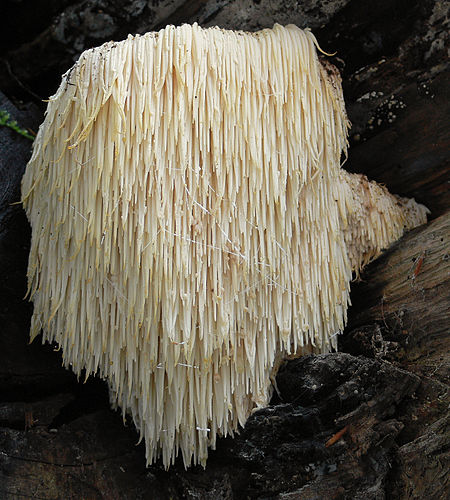Introduction
Hericium erinaceus, an extraordinary edible mushroom, is increasingly becoming the focus of Alzheimer’s research. Its rich range of bioactive substances gives it the status of a “medical mushroom” (MM) and makes it a fascinating object of research.
The mushroom has had a place in traditional Chinese medicine for centuries, where it is mainly used to treat gastrointestinal complaints. Its neuroprotective potential is becoming increasingly apparent, for example in Japan, where it is mainly used to treat neurological disorders of the central nervous system. In Europe, it is mainly consumed as an edible mushroom, but is also available as an over-the-counter dietary supplement.
Young mushrooms are white, become cream-colored with increasing age and are yellow-brown to brown when they are older. Because of its unique appearance with numerous long “spines”, it is also known as lion’s mane, monkey’s head, hedgehog’s goatee, pom-pom or yamabushitake. The mushroom is mainly native to Asia, North America and Europe. In Europe, it can be found in deciduous forests in Poland, Hungary, the Czech Republic, the Netherlands, Slovakia, Romania, Bulgaria, Portugal, Italy, Sweden, Denmark and Spain. It typically grows in knotholes or wounds in deciduous trees such as oak, walnut or beech.
The mushroom contains numerous primary plant substances such as amino acids, nucleotides and organic acids as well as a large number of secondary plant substances such as flavonoids, phenolic acids, phenylpropanoids, steroids, terpenoids and unsaturated fatty acids.
Two secondary plant substances from the group of terpenoids (cyathan diterpenes) are primarily responsible for the neuroprotective effect of the mushroom: hericenones and erinacins. Hericenones are mainly obtained from the mycelium, while the erinacins come from both the fruiting body and the mycelium. The most important subgroups for Alzheimer’s research are Hericenone A, Hericenone D and Hericenone S as well as Erinacine A, Erinacine S and Erinacine E, whereby the letters indicate the different chemical structure variants of the subgroups [1].
What does the fungus do in the Alzheimer’s brain?
Hericium erinaceus can have a protective effect on the nervous system by performing various functions such as inhibiting Alzheimer’s-specific deposits, combating oxidative stress, reducing inflammation in the brain, promoting the growth of nerve cells and regulating the transmission of signals between nerve cells.

Photo 2
Anti-amyloid functions
- The deposition of amyloid-beta (Aß) proteins and the resulting death of neurons (nerve cells) is considered to be a central mechanism in the development of Alzheimer’s disease.
- Aß deposit develop when certain Aß proteins are incorrectly cut out of the amyloid precursor protein (APP) and subsequently fold incorrectly, resulting in the formation of more Aß plaques. These deposits in turn trigger neuronal disorders and inflammatory reactions, which lead to neuronal cell death and shrinkage of the brain volume and thus to the progression of Alzheimer’s disease.
In mice and rats, Hericium erinanceus has been shown to reduce the deposition of Aß by increasing the expression of an enzyme called insulin-degrading enzyme (IDE), which breaks down amyloidß (Aß). It also reduces enzymes that support the deposition of Aß [5].
Antioxidant functions
Another well-researched reason for the development of Alzheimer’s disease is the increased formation of free oxygen radicals (ROS), which also occur to a physiological extent in healthy people during energy metabolism. In Alzheimer’s patients, however, ROS formation can be too high, leading to oxidative stress, an imbalance between ROS and antioxidant forces in the body. ROS can damage nerve cells and promote their premature death, which can contribute to the development of Alzheimer’s disease.
Animal and molecular studies have shown that Hericum erinaceus has antioxidant properties by upregulating antioxidant enzymes such as glutathione peroxidase, catalase and superoxide dismutase. Glutathione peroxidase plays a crucial role in the regeneration of glutathione, the most important antioxidant in the brain, which must be present in its chemically reduced form in order to scavenge ROS. When reduced glutathione neutralizes ROS in the brain, it can help reduce Aß plaque formation and improve memory performance in Alzheimer’s patients.
In addition, the fungus can regulate the so-called Nrf2. Nrf2 is a protein that can regulate certain genes and encodes proteins in the body that act as endogenous stress response proteins, excretory enzymes or antioxidant enzymes. Animal studies have shown that an extract of Hericum erinaceus reduces the formation of TBARS (a series of molecules that are end products and thus markers of lipid peroxidation), indicating, for example, reduced membrane peroxidation. In Alzheimer’s patients, lipid peroxidation and its end products, TBARS, are usually elevated, indicating increased oxidative stress in the brain [5].
Antineuroinflammatory functions
Furthermore, Alzheimer’s patients have increased levels of inflammatory markers such as IL-1ß, TNF-a and IL-6, which is associated with increased neuroinflammation (inflammation in the brain). This inflammatory reaction can damage nerve cells, promote the formation of Aß plaques and lead to a deterioration in cognitive abilities.
Hericum erinaceus shows anti-inflammatory properties in animal and molecular studies by reducing the activation of the NLRP3 inflammasome. The NLRP3 inflammasome is a term for cellular multiprotein complexes of the innate immune system that are responsible for the activation of inflammatory reactions. They recognize certain stimuli and trigger inflammation by producing inflammatory markers such as IL-1ß, IL-6 and TNF-a [5].
Neurotrophic functions
Neurotrophic factors such as nerve growth factor (NGF) are proteins that stimulate the differentiation of nerve cells and initiate processes that are important for the development, maintenance, function and regeneration of nerve cells and thus ensure their survival.
Extracts from Hericum erinaceus can promote the release of NGF. Elevated NGF levels are associated with the formation of new neurons, neuronal plasticity in the hippocampus (brain region responsible for learning and memory), in the pituitary gland and in the cortex. NGF also activates signaling pathways that contribute to the proliferation and maintenance of nerve cells and to the development of memory abilities in neuronal precursor cells.
Furthermore, NGF can cause a remodeling of the mitochondria (power plants of the cells), which increases the capacity of cellular energy. This is important because the energy is produced in the mitochondria, on which nerve cells are particularly dependent. In neurodegenerative diseases such as Alzheimer’s or Parkinson’s, damage to the mitochondria is often detected, which in turn impairs the functionality of the nerve cells and thus contributes to these diseases [5].
Neurotransmission functions
Neurotransmitters such as acetylcholine (ACh) are messenger substances that transmit signals between nerve cells. ACh is formed from choline and acetyl-CoA, an end product of glycolysis (first phase of energy production from sugar). A lack of acetylcholine has been observed in Alzheimer’s patients, which may be caused by disturbances in sugar metabolism. In addition, the enzyme acetylcholinesterase breaks down acetylcholine excessively quickly in Alzheimer’s patients.
Animal studies have shown that supplementation with Hericum erinaceus can improve this so-called cholinergic function by increasing ACh and choline acetyltransferase levels in mice. Hericum erinaceus can also stimulate the release of the neurotransmitter glutamate in the hippocampus. Glutamate is the most common excitatory neurotransmitter in mammals, and changes in glutamate metabolism have been linked to the onset and development of Alzheimer’s disease [5].
Clinical studies – facts for Alzheimer’s patients

Picture 3
The exact mechanisms of action of Hericum erinaceus are only known from animal and molecular studies. However, there are also clinical studies that prove the neuroprotective effect of the mushroom in Alzheimer’s patients.
Study 1 – Li et al, 2020
In the most recent study by Li et al. from 2020, the effect of Hercium erinaceus was investigated in 41 women and men with mild Alzheimer’s disease. The study comprised a 3-week screening phase followed by a 49-week double-blind treatment phase with two parallel groups. The intervention group received three 350 mg capsules of a Hericium erinaceus formulation containing 5 mg/g erinacin A per day for a period of 49 weeks, while the control group took an identical placebo with food.
During the intervention period, cognitive tests (MMSE, IADL, NPI, CASI) were carried out after 13, 25 and 49 weeks to determine changes in cognitive abilities. After 25 weeks, the placebo group showed a deterioration in the CASI test compared to the intervention group. After 49 weeks, the intervention group showed an improvement in the MMSE test. These results indicate improved or better preserved cognitive abilities in the intervention group. In addition, the intervention group showed higher scores in the IADL test after 49 weeks, which indicates improved independence in everyday life and less need for care. In addition, blood markers such as calcium, albumin, hemoglobin, homocysteine, superoxide dismutase, BDNF, APOE4 and α-ACT also improved in the intervention group. These changes indicate a positive change in the brain, which may mean a slowdown in cognitive decline [2].
Study 2 – Saitsu et al, 2019
A study by Saitsu et al. from 2019 came to similar conclusions. Thirty-one healthy test subjects (> 50 years) were divided into two groups. The intervention group consumed 4 Hericium erinaceus supplements containing 0.8 g of Hericium erinaceus each day for 12 weeks. The cognitive changes were examined using the Minimal Mental Status Test (MMSE), the Benton Visual Tentetion Test and the Standard verbal paired-axxociate learning Test (S-Pa).
Compared to the placebo group, the intervention group showed improved MMSE values. This indicates improved cognitive retention in the intervention group. No significant differences were found in the other two tests [4].
Study 3 – Mori et al, 2009
In a somewhat older study by Mori et al. from 2009, 31 Japanese men and women (aged 50-80) with mild cognitive impairment were divided into two groups. The intervention group received four 250 mg tablets each containing 96% Hericium erinaceus every day for 16 weeks, while the placebo group received a visually similar placebo preparation. Changes in cognitive abilities were assessed using a cognitive test called the Revies Hasegawa Dementia Scale (HDS-R), a verbal and graphic test that measures spatial-visual and constructive functions.
The intervention group improved their values after 8, 12 and 16 weeks compared to the placebo group. However, these improvements decreased again 4 weeks after the intervention, which indicates the need for continuous use. It should be noted that the values of the placebo group also showed significant improvements at weeks 8 and 16 compared to the start of the study. Possible causes for this could be the placebo effect or the test subjects getting used to the cognitive function test [3].
What is important when taking Hericium erinaceus?
In the studies, doses of 1 to 3.2 grams were taken over a period of 12-49 weeks, with continuous intake recommended for long-lasting effects. It is important to pay attention to the quality of the product, such as organic quality and hand processing, as well as to reputable manufacturers and sellers. Combination with other therapies should also be considered.
Possible side effects can include gastrointestinal complaints and digestive problems.
For individual advice and treatment recommendations, it is advisable to consult a doctor or alternative practitioner.
Conclusion
The edible mushroom Hericium erinaceus is rich in bioactive substances. Numerous neuroprotective functions have been demonstrated in animal and molecular studies, which have also led to positive and significant results in clinical studies with Alzheimer’s patients. As a dietary supplement, it is generally well tolerated, although side effects such as gastrointestinal complaints and indigestion can occur.
Like most therapeutic agents for Alzheimer’s disease, this mushroom cannot completely cure the disease. However, it can have a protective effect and help to alleviate the symptoms of Alzheimer’s disease.
To find out more about possible treatment methods or the exact mechanisms of dementia, click here.
References
- Brandalise, F., Roda, E., Ratto, D., Goppa, L., Gargano, M. L., Cirlincione, F., Priori, E. C., Venuti, M. T., Pastorelli, E., Savino, E., & Rossi, P. (2023). Hericium erinaceus in Neurodegenerative Diseases: From Bench to Bedside and Beyond, How Far from the Shoreline? Journal of Fungi, 9(5), Article 5. https://doi.org/10.3390/jof9050551
- Li, I.-C., Chang, H.-H., Lin, C.-H., Chen, W.-P., Lu, T.-H., Lee, L.-Y., Chen, Y.-W., Chen, Y.-P., Chen, C.-C., & Lin, D. P.-C. (2020). Prevention of Early Alzheimer’s Disease by Erinacine A-Enriched Hericium erinaceus Mycelia Pilot Double-Blind Placebo-Controlled Study. Frontiers in Aging Neuroscience, 12. https://doi.org/10.3389/fnagi.2020.00155
- Mori, K., Inatomi, S., Ouchi, K., Azumi, Y., & Tuchida, T. (2009). Improving effects of the mushroom Yamabushitake (Hericium erinaceus) on mild cognitive impairment: A double-blind placebo-controlled clinical trial. Phytotherapy Research, 23(3), 367-372. https://doi.org/10.1002/ptr.2634
- Saitsu, Y., Nishide, A., Kikushima, K., Shimizu, K., & Ohnuki, K. (2019). Improvement of cognitive functions by oral intake of Hericium erinaceus. Biomedical Research, 40(4), 125-131. https://doi.org/10.2220/biomedres.40.125
- Yanshree, Yu, W. S., Fung, M. L., Lee, C. W., Lim, L. W., & Wong, K. H. (2022). The Monkey Head Mushroom and Memory Enhancement in Alzheimer’s Disease. Cells, 11(15), Article 15. https://doi.org/10.3390/cells11152284
Picture 1 from https://de.wikipedia.org/wiki/Igel-Stachelbart
Picture 2 by Gerd Altmann on Pixabay
Picture 3 from Patrick Tomasso on Unsplash



